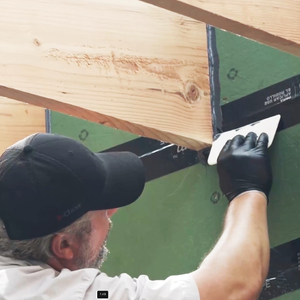Hello.
When should one use floating trimmer studs? When should one use continuous trimmers?
Why use one over the other? I read that it is best to use floating trimmers for wood windows, is this still the case? How does it help when installing wood windows?
Thanks


















Replies
Always use a continuos trimmer when not sure. Where I'm from it is code. At least you will be 100% sure of having no problems. Besides, why not use a continuos trimmer when framing new?
Thanks Joe. Why did floating trimmers come about?
Why did floating trimmers come about?
Bob Vila and Tim Uhler invented them............;-)
I have no idea because I've never used them before. The only time I do something that will look like them is when we have to to shrink down a rough opening for a small window or door.
Joe Carola
Edited 7/19/2008 2:26 pm ET by Framer
Please explain floating trimmer please? I suspect I know, but have never used that terminology.
Just to clear up the confusion here is a pic.
I call that a split trimmer. I don't think it meets code here, though I have never pushed it. I run a full length trimmer and then toenail the sill into the king/trimmer instead of nailing the extra cripple underneath the end of the sill. Seems to work fine and eliminates a bit of thermal bridging.
I am not a framer!"I run a full length trimmer and then toenail the sill into the king/trimmer instead of nailing the extra cripple underneath the end of the sill. Seems to work fine and eliminates a bit of thermal bridging."But I was just going to ask the question of why not to do it that way.The rough sill has minimal loads. All fo the loads are carried by the header/full lenght trimmer.And if you have a wider window then you have the cripples in bewteen to help support it..
.
A-holes. Hey every group has to have one. And I have been elected to be the one. I should make that my tagline.
Please explain floating trimmer please?
I never heard of that either till today, but either way, it's a split trimmer/liner/jack. (I alwys called them liners).
Joe Carola
Ok, that is what I thought they were talking about. We have done it, but BI don't like it.
Dbl. sill not required around here!
When should one use floating trimmer studs? When should one use continuous trimmers?
Wow, you may get into to terminology issues here.
If you can attach a sketch or photo, even cell phone pics, it may help.
I think what you mean is do you go, King; Jack (to header); cripple/trimmer (to sill)
Versus King; cripple/trimmer to sill; then cripple/trimmer to header.
First method is traditional, but yields 4.5" of thermally-bridging lumber under both window jams.
Second method is used--often badly--in tract construction, mostly to save a stick per jamb when building thousands of houses per year.
But, I'm guessing here.
You got it CapnMac. Why use one over the other? Cost? What advantage do you have by going King,cripple to sill then cripple to header over King, Jack to header, cripple to sill.Thanks
I'm talking about two different ways and your using the same amount of studs.
#1 King stud, trimmer from shoe to bottom of header. (passes everywhere)
#2 King stud, trimmer from shoe to bottom of double window sill, then from top of window sill to bottom of header.(doesn't pass everywhere)Joe Carola
Hey Joe do you use double sills under your windows?
Yes, it's code. I think it's stupid but it's code.There's no need for double sills. When I first started framing it wasn't.Joe Carola
Double sills are required by code Joe?
Where I'm from they are.
Joe Carola
What advantage do you have by going King,cripple to sill then cripple to header
It's only 3" wide. Thermally, it's less mass, right where any air leaks or frame-to-framing conductivity might bring temperature changes through the wall.
Down side of the "broken" jack/trimmer is that it reallys needs accurate cutting to get a nice level & square sill. In tract houses, not so bad, they just leave a 3/8 -1/2 shim space (almost better for insulating, in some ways; sub-optimal for framing).
Now, other places may not have seen a trimmer/cripple supporting the sill, but those places probably don't "see" the amount of brick veneer we here in Texas do, with brick sills and returns around windows bearing against the framing.
Now, in commercial work, you block the wall, but set the window frame to span the gap to the brick veneer. The frame to brick gap gets backer rod and pookie. This will make a person used to wood sinding & flanged windows head scratch no end <G>.Occupational hazard of my occupation not being around (sorry Bubba)
"The frame to brick gap gets backer rod and pookie."All right, I'll bite. What's pookie? Since it apparently goes with backer rod, I'm guessing some kind of caulk?
BruceT
What's pookie?
Well, gazillions of years ago, "pookie" was specifically a fireproof sealant one put around pipes so that the penetrations could be fire-rated. A clay material with strands of fire-resistant fiber, sometimes requiring water, or additional water to come to workable consistency.
Pookie on commercial sites can cover any number of materials.
Over backer rod, the term-of-art is "flexible sealant"--so it can be silicone, rubberized, or similar sorts of products; even, occassionally, caulk. <g>Occupational hazard of my occupation not being around (sorry Bubba)
What is a floating trimmer?
Sure am glad I'm not the only one!
See illustration in xxxxxx.8 of this thread - you will understand.
Blownonfuel : "floating trimmer" not legal here. Have done similar to skinny up an existing opening.
Double sills not required by code - but the BI loves them! I generally choose single vs double sills based on the specified trim for window / door. If I have a three piece 4" wide trim to nail up, it sure is nice to have that double sill.
JimNever underestimate the value of a sharp pencil or good light.
I see now. Never knew they had a name.
Blown
In Iowa, I have never seen anything but floating trimmers.
That's the way I was taught and I am fairly sure that nearly eveeryone does it that way.
Rich
Okay...heres a test for the engineer types.Which system is better? In terms of shear? In terms of strength? In terms of it's ability to hold weight? Does the crush factor of the sill mean anything in the equation? Does the fact that the trimmer is split weaken the post? Bob's next test date: 12/10/07
Jim
Okay...heres a test for the engineer types.
That rules me out.
Does it matter which one is stronger, as long as it will carry the load it was designed for?
This article from FHB does framing without any trimmers at all. Just Simpson type plates at the corners.
http://www.taunton.com/finehomebuilding/how-to/articles/future-framing-walls.aspx?LangType=1033&ac=fp
Rich
Edited 7/20/2008 9:52 am ET by cargin
No, it doesn't matter. I was just wondering if the topic bore some discussion....after all, this is a construction discussion forum! Or, we could concentrate our mental efforts on more important things like black diamonds, osb vs ply, or "it's Bushes fault". Bob's next test date: 12/10/07
Jim
I'm with you. Discuss away.
Whatever it is, Bush is to blame, Al Gore invented it and Obama ill change it to make it all better.
Rich
Anyone who has done much remodelling knows that headers wind up being supported by the nails into the king instead of the trimmers. I remodelled a lodge in the Cascade Mtns of Washington (180 psf snow load, and that isn't just theoretical--they get that). Yet you take apart a critical bearing wall, and every header has shrunk up 1/4 to 1/2" off of the trimmer. This was a 80 year old building. I don't really have a point here, because of course I'm going to keep using trimmers. But it makes the issue of whether you can split a trimmer or not seem a little inconsequential. Me, I gotta do what the man (BI) says.
Edited 7/20/2008 11:10 am ET by Marson
I agree. The nails hold the header...assuming there are some. 80 years ago, they were pounding 16 commons. They had a lot of shear strength. Nowadays, they shoots some .131 gun nails. There's significantly less shear strength with that approach. The other consideration is the blow out resistance that the full length trimmer supplies. The full king does a crackerjack job of holding everything from collapsing. The trimmer, if full length adds additional support. I've had many plans call for the doubling of the king stud, with a single trimmer to beef up the post strength. I did one for Pulte once that required SEVEN kings and two trimmers. Bob's next test date: 12/10/07